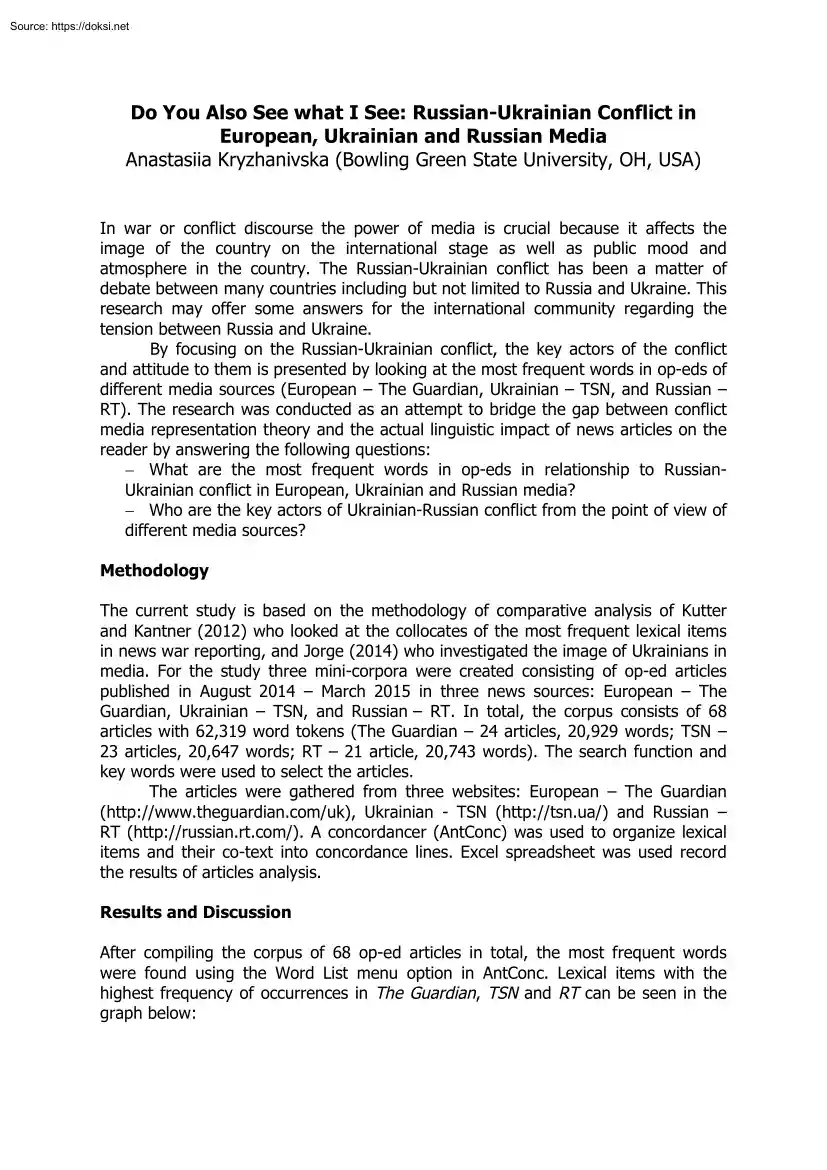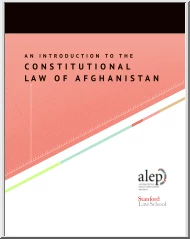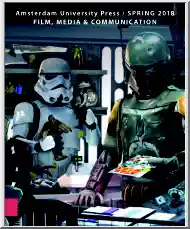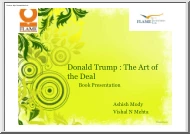A doksi online olvasásához kérlek jelentkezz be!

A doksi online olvasásához kérlek jelentkezz be!
Nincs még értékelés. Legyél Te az első!
Mit olvastak a többiek, ha ezzel végeztek?
Tartalmi kivonat
Do You Also See what I See: Russian-Ukrainian Conflict in European, Ukrainian and Russian Media Anastasiia Kryzhanivska (Bowling Green State University, OH, USA) In war or conflict discourse the power of media is crucial because it affects the image of the country on the international stage as well as public mood and atmosphere in the country. The Russian-Ukrainian conflict has been a matter of debate between many countries including but not limited to Russia and Ukraine. This research may offer some answers for the international community regarding the tension between Russia and Ukraine. By focusing on the Russian-Ukrainian conflict, the key actors of the conflict and attitude to them is presented by looking at the most frequent words in op-eds of different media sources (European – The Guardian, Ukrainian – TSN, and Russian – RT). The research was conducted as an attempt to bridge the gap between conflict media representation theory and the actual linguistic impact of news
articles on the reader by answering the following questions: - What are the most frequent words in op-eds in relationship to RussianUkrainian conflict in European, Ukrainian and Russian media? - Who are the key actors of Ukrainian-Russian conflict from the point of view of different media sources? Methodology The current study is based on the methodology of comparative analysis of Kutter and Kantner (2012) who looked at the collocates of the most frequent lexical items in news war reporting, and Jorge (2014) who investigated the image of Ukrainians in media. For the study three mini-corpora were created consisting of op-ed articles published in August 2014 – March 2015 in three news sources: European – The Guardian, Ukrainian – TSN, and Russian – RT. In total, the corpus consists of 68 articles with 62,319 word tokens (The Guardian – 24 articles, 20,929 words; TSN – 23 articles, 20,647 words; RT – 21 article, 20,743 words). The search function and key words were used to
select the articles. The articles were gathered from three websites: European – The Guardian (http://www.theguardiancom/uk), Ukrainian - TSN (http://tsnua/) and Russian – RT (http://russian.rtcom/) A concordancer (AntConc) was used to organize lexical items and their co-text into concordance lines. Excel spreadsheet was used record the results of articles analysis. Results and Discussion After compiling the corpus of 68 op-ed articles in total, the most frequent words were found using the Word List menu option in AntConc. Lexical items with the highest frequency of occurrences in The Guardian, TSN and RT can be seen in the graph below: Graph 1 The most frequent words comparison 180 160 140 120 100 The Guardian 80 TSN 60 RT 40 20 0 Ukraine Russia Putin Russian war people country year/ years The above graph shows that the most frequent lexical items in The Guardian and in TSN coincide: Ukraine, Russia, Putin, Rusian, war. However, RT suggests a slightly different
sequence: Ukraine, Russia, country, year/years, people. Obviously, Ukraine and Russia are considered to be key actors in all three sources, even though the number of occurrences of these words is not the same. Russia is the most frequently used lexical item in Ukrainian source TSN; adjective Russian takes the second place. In RT, however, Ukraine is the most frequently mentioned word. For The Guardian, Ukraine, Russia and Putin have approximately the same frequency. This analysis reveals that from the Ukrainian media perspective, Russia’s actions deserve the most attention. From the Russian perspective, on the contrary, Ukraine is the one that has to be mentioned the most. And The Guardian, as the third party, equally describes Ukraine, Russia and Russian representative Putin. Moreover, this comparison suggests that RT does not use the word war very often, unlike The Guardian and TSN where it is used at least three times more often. The reason for this big difference in frequency of
occurrences might be the fact that Russian-Ukrainian conflict is not considered as war in Russia. It is usually viewed as misunderstanding between the countries and people. This point of view is also reflected in the frequency of use of these two lexical items. Similarly to Chen (2013), it was assumed that rare mentioning of government tells about the government’s ineffective role in the conflict. Instead, the articles use personal names (places, people, etc.) to particularize the actions In addition, instead of covering only the current state of affairs in the country, the Russian media tends to recollect events happened in the past year/years. Assumptions about future events can be made based on the previous experiences and conflicts between Russia and other countries. Three mini-corpora were also analyzed in terms of the proper names (names, places, countries, capitals) that are expected to appear in op-eds due to their immediate relevance to the Russian-Ukrainian conflict. The
following graph compares the use of personal names across three mini-corpora: Graph 2 Personal names frequency comparison 140 120 100 80 The Guardian TSN 60 40 20 0 The above graph shows that each media source represents the Russian-Ukrainian conflict in relation to respective country. So that, European The Guardian sees Europe among active participants, Ukrainian TSN considers Crimea to be crucial in the conflict, and Russian RT has Moscow in top three actors. The more careful investigation of data, however, reveals certain difference between how the personal names are used in different contexts. The most frequent personal name in The Guardian and TSN is Putin. The prevalent number of its occurrences tells that he is one of the key actors in RussianUkrainian conflict. RT’s most frequent personal name is USA The media represents the US as Ukrainian ally who is going to provide it with weapons and send humanitarian support. Even though the American government declined
Ukrainian appeal for help, the mere intention to do that in the past brought the United States into the foreground of RT’s discussion. Kiev and Moscow are both very frequent personal names in all three corpora. Interestingly, Kremlin is sometimes used as a substitute of Moscow and Russian government in general in TSN. The occurrence of this lexical item is twice more frequent in Ukrainian source than in The Guardian, and at least three times more frequent than in RT. Indeed, referring to either Russian president Putin or Russian government in Kremlin is not very common in RT. It might be explained by the overall shifted focus of Russian-Ukrainian conflict in Russian media so that the attention is paid to Europe, USA and Kiev instead of to the actions of the Russian government or Moscow. Poroshenko and Obama are almost equally mentioned across all three corpora even though only one of them is directly connected to the ongoing conflict. It could be attributed to the fact that
Poroshenko’s presidency term has recently started at that time, which does not make him responsible for the decisions made by previous government. Kiev instead is a more general term to be used referring to the Ukrainian government. An interesting correlation between Donetsk, Luhansk, and Donbas can be seen across three corpora. Only Ukrainian TSN acknowledges that the ongoing conflict concerns the whole Donbas region, and not only particular parts of it, such as Donetsk and Luhansk. It tells about the general awareness about the real situation in Eastern Ukraine. European and Russian media seems to separate Donetsk and Luhansk and single them out from other parts of Donbas region, and hence – limiting the conflict to only those two cities. In reality, every village, town and city in close distance to Donetsk and Luhansk is involved. Germany in The Guardian and RT is mentioned almost equally. The co-text of this lexical item is very different, though. The Guardian nominates
Germany as the most influential country representing the European Union. But RT describes it as Ukrainian ally along with the USA. Even though German government expressed its sincere concern about the situation in Ukraine, no significant action has been undertaken. The Guardian compared Putin to a historical figure of Hitler, saying that their methods of taking over the territory are very similar. However common this comparison in Ukraine is, only one occurrence of Hitler was found in TSN. At the same time, RT mentions Hitler as a response to the comparison of Putin to Hitler, usually impersonalizing and passivizing the accusation (it is said that; Putin is compared to). Conclusions Based on the above results, it appears that the most frequent lexical items with regards to the Russian-Ukrainian conflict in op-eds in The Guardian and TSN are: Ukraine, Russia, Putin, Russian, and war. The most frequent words in RT are: Ukraine, Russia, people, country, and year/ years. Even though three
mini-corpora included only 62,319 word tokens in 68 articles from three media sources, the results show the difference of the conflict media coverage in different countries. The Guardian blames Putin, the Russian paper blames the USA, and TSN emphasizes the hardships of the current situation in Ukraine and highlights the war conflict. References Chen, S. (2013) Corpus linguistics in critical discourse analysis: a case study on news reports of the 2011 Libyan civil war. Stream: Culture/Politics/Technology, 5(1). Jorge, T. (2014, July) Media’s symbolic power: RT and The Guardian’ discursive construction of the EuroMaidan protests and Crimean annexation. Aalborg Universitet. Kutter, A., & Kantner, C (2012) Corpus-based content analysis: a method for investigating news coverage on war and intervention. Stuttgart: Stuttgart University
articles on the reader by answering the following questions: - What are the most frequent words in op-eds in relationship to RussianUkrainian conflict in European, Ukrainian and Russian media? - Who are the key actors of Ukrainian-Russian conflict from the point of view of different media sources? Methodology The current study is based on the methodology of comparative analysis of Kutter and Kantner (2012) who looked at the collocates of the most frequent lexical items in news war reporting, and Jorge (2014) who investigated the image of Ukrainians in media. For the study three mini-corpora were created consisting of op-ed articles published in August 2014 – March 2015 in three news sources: European – The Guardian, Ukrainian – TSN, and Russian – RT. In total, the corpus consists of 68 articles with 62,319 word tokens (The Guardian – 24 articles, 20,929 words; TSN – 23 articles, 20,647 words; RT – 21 article, 20,743 words). The search function and key words were used to
select the articles. The articles were gathered from three websites: European – The Guardian (http://www.theguardiancom/uk), Ukrainian - TSN (http://tsnua/) and Russian – RT (http://russian.rtcom/) A concordancer (AntConc) was used to organize lexical items and their co-text into concordance lines. Excel spreadsheet was used record the results of articles analysis. Results and Discussion After compiling the corpus of 68 op-ed articles in total, the most frequent words were found using the Word List menu option in AntConc. Lexical items with the highest frequency of occurrences in The Guardian, TSN and RT can be seen in the graph below: Graph 1 The most frequent words comparison 180 160 140 120 100 The Guardian 80 TSN 60 RT 40 20 0 Ukraine Russia Putin Russian war people country year/ years The above graph shows that the most frequent lexical items in The Guardian and in TSN coincide: Ukraine, Russia, Putin, Rusian, war. However, RT suggests a slightly different
sequence: Ukraine, Russia, country, year/years, people. Obviously, Ukraine and Russia are considered to be key actors in all three sources, even though the number of occurrences of these words is not the same. Russia is the most frequently used lexical item in Ukrainian source TSN; adjective Russian takes the second place. In RT, however, Ukraine is the most frequently mentioned word. For The Guardian, Ukraine, Russia and Putin have approximately the same frequency. This analysis reveals that from the Ukrainian media perspective, Russia’s actions deserve the most attention. From the Russian perspective, on the contrary, Ukraine is the one that has to be mentioned the most. And The Guardian, as the third party, equally describes Ukraine, Russia and Russian representative Putin. Moreover, this comparison suggests that RT does not use the word war very often, unlike The Guardian and TSN where it is used at least three times more often. The reason for this big difference in frequency of
occurrences might be the fact that Russian-Ukrainian conflict is not considered as war in Russia. It is usually viewed as misunderstanding between the countries and people. This point of view is also reflected in the frequency of use of these two lexical items. Similarly to Chen (2013), it was assumed that rare mentioning of government tells about the government’s ineffective role in the conflict. Instead, the articles use personal names (places, people, etc.) to particularize the actions In addition, instead of covering only the current state of affairs in the country, the Russian media tends to recollect events happened in the past year/years. Assumptions about future events can be made based on the previous experiences and conflicts between Russia and other countries. Three mini-corpora were also analyzed in terms of the proper names (names, places, countries, capitals) that are expected to appear in op-eds due to their immediate relevance to the Russian-Ukrainian conflict. The
following graph compares the use of personal names across three mini-corpora: Graph 2 Personal names frequency comparison 140 120 100 80 The Guardian TSN 60 40 20 0 The above graph shows that each media source represents the Russian-Ukrainian conflict in relation to respective country. So that, European The Guardian sees Europe among active participants, Ukrainian TSN considers Crimea to be crucial in the conflict, and Russian RT has Moscow in top three actors. The more careful investigation of data, however, reveals certain difference between how the personal names are used in different contexts. The most frequent personal name in The Guardian and TSN is Putin. The prevalent number of its occurrences tells that he is one of the key actors in RussianUkrainian conflict. RT’s most frequent personal name is USA The media represents the US as Ukrainian ally who is going to provide it with weapons and send humanitarian support. Even though the American government declined
Ukrainian appeal for help, the mere intention to do that in the past brought the United States into the foreground of RT’s discussion. Kiev and Moscow are both very frequent personal names in all three corpora. Interestingly, Kremlin is sometimes used as a substitute of Moscow and Russian government in general in TSN. The occurrence of this lexical item is twice more frequent in Ukrainian source than in The Guardian, and at least three times more frequent than in RT. Indeed, referring to either Russian president Putin or Russian government in Kremlin is not very common in RT. It might be explained by the overall shifted focus of Russian-Ukrainian conflict in Russian media so that the attention is paid to Europe, USA and Kiev instead of to the actions of the Russian government or Moscow. Poroshenko and Obama are almost equally mentioned across all three corpora even though only one of them is directly connected to the ongoing conflict. It could be attributed to the fact that
Poroshenko’s presidency term has recently started at that time, which does not make him responsible for the decisions made by previous government. Kiev instead is a more general term to be used referring to the Ukrainian government. An interesting correlation between Donetsk, Luhansk, and Donbas can be seen across three corpora. Only Ukrainian TSN acknowledges that the ongoing conflict concerns the whole Donbas region, and not only particular parts of it, such as Donetsk and Luhansk. It tells about the general awareness about the real situation in Eastern Ukraine. European and Russian media seems to separate Donetsk and Luhansk and single them out from other parts of Donbas region, and hence – limiting the conflict to only those two cities. In reality, every village, town and city in close distance to Donetsk and Luhansk is involved. Germany in The Guardian and RT is mentioned almost equally. The co-text of this lexical item is very different, though. The Guardian nominates
Germany as the most influential country representing the European Union. But RT describes it as Ukrainian ally along with the USA. Even though German government expressed its sincere concern about the situation in Ukraine, no significant action has been undertaken. The Guardian compared Putin to a historical figure of Hitler, saying that their methods of taking over the territory are very similar. However common this comparison in Ukraine is, only one occurrence of Hitler was found in TSN. At the same time, RT mentions Hitler as a response to the comparison of Putin to Hitler, usually impersonalizing and passivizing the accusation (it is said that; Putin is compared to). Conclusions Based on the above results, it appears that the most frequent lexical items with regards to the Russian-Ukrainian conflict in op-eds in The Guardian and TSN are: Ukraine, Russia, Putin, Russian, and war. The most frequent words in RT are: Ukraine, Russia, people, country, and year/ years. Even though three
mini-corpora included only 62,319 word tokens in 68 articles from three media sources, the results show the difference of the conflict media coverage in different countries. The Guardian blames Putin, the Russian paper blames the USA, and TSN emphasizes the hardships of the current situation in Ukraine and highlights the war conflict. References Chen, S. (2013) Corpus linguistics in critical discourse analysis: a case study on news reports of the 2011 Libyan civil war. Stream: Culture/Politics/Technology, 5(1). Jorge, T. (2014, July) Media’s symbolic power: RT and The Guardian’ discursive construction of the EuroMaidan protests and Crimean annexation. Aalborg Universitet. Kutter, A., & Kantner, C (2012) Corpus-based content analysis: a method for investigating news coverage on war and intervention. Stuttgart: Stuttgart University




